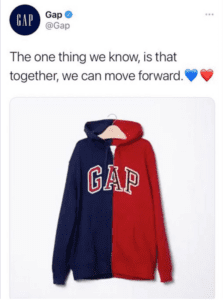Brands voting “yes” on taking a stance can be risky – but abstaining may be even riskier.
Not too long ago, politics was considered one of 3 subjects that were a definite no-no to bring up at the dinner table. However, social media has thrown traditional politesse out the window and now everyone – including brands – are being asked to take a political stance.
Our Defero-led poll shows that 58% of people think their favorite brands shouldn’t get mixed up in the political realm. However, a study from Edelman shows that businesses are 4x more likely to gain consumer trust by taking on social issues. But with 55% of people fed up seeing politics dominating their social feeds, it’s hard for brands to not just decide how to present their stance on hot-button issues, but should they even have one at all?
Are you looking for ideas on how (or if) your brand should draw a line in the sand? We’ve outlined 3 brands who’ve mastered the art of taking a stance, as well as 3 who missed the mark.
However, if this is TL; DR, skip to the end and review our top questions to ask before going public with your brand’s views.
So – are you ready to talk politics?
Political Pros
These 3 brands demonstrate a winning strategy when taking a political stance.
Patagonia
This outerwear giant puts their money where their mouth is to keep the great outdoors great.
What they do right:
- Activism aligns with business and customer values. When making clothing for people who care about the environment, show them that your brand cares about the environment, too.
- It’s more than a social post. Patagonia’s activism isn’t just lip service. Not only do they have a program to help recycle already-loved Patagonia pieces, but they have a tab highlighting their social work front and center on their navigation page.
- It’s clear. From their lawsuit against former President Trump to those infamous garment tags, the brand and its founder, Yvon Chouinard, do not mince words when it comes to making their stance on social issues known.
Ben and Jerry’s

America’s favorite ice cream brand is known for its commitment to peace, love, and good ice cream. But they’re equally famous for their unapologetic political activism.
What they do right:
- It’s transparent. A portion of their website is dedicated to their stance on hot-button issues like sustainable food solutions and the refugee crisis.
- Activism aligns with their business values. Ben and Jerry’s activism is rooted in their business’s mission statement. They aim to create a “linked prosperity” for everyone connected to their business using fair practices rooted in equality.
- It inspires trust. Taking a political stance they believe will make the world a better place endears them to their audience. It gives buyers a reason to trust that the brand will not only put effort into doing good but that they’ll go to great lengths to create good ice cream.
Glossier
This beauty behemoth donates to a handful of social justice organizations. They also award grants to Black-owned beauty businesses.
What they did right:
- It’s transparent. Not only does Glossier publicly list the organizations they donate to, but they keep consumers apprised of the grant program’s status on social media and their blog.
- They stay true to their brand. Putting followers’ needs first is how Glossier came to be, so listening to and supporting their audience’s values are natural to the brand.
- It’s more than a post. Supporting other businesses competing in the same vertical shows that Glossier cares more about the cause than their bottom line. This inspires trust and admiration among their followers and non-followers alike.
Forced to Resign
These 3 brands conceded that their response to social issues was less than perfect.
GAP

GAP’s appeal for unity in the form of a red-and-blue jacket quickly grew out of style for its failure to take on a clear point of view.
What they did wrong:
- It’s vague. Saying your brand values unity isn’t enough. You must spell out exactly what unity means to your brand.
- It’s trivial. The issues dividing our nation are much heavier than a zip-up hoodie.
- It lacks values. GAP’s target audience of socially conscious Gen-Zers and Millennials are put off by the brand’s inability to take a pointed stance.
Pepsi

This infamous commercial is the OG example of how brands should not take a political stance.
What they did wrong:
- It’s vague. It’s not clear what the protestors in the ad are fighting for. Given its proximity to the 2016 Black Lives Matter movement, many assume it’s about racial equality.
- It’s trivial. If only the world’s issues can be solved with soda. That’s the theme of the ad, which is problematic considering issues like racial inequality are extremely complex, serious, and will take a great deal of time and effort to dismantle.
- It’s tone-deaf. A white, privileged model walking effortlessly to the front lines of a protest and giving a police officer some pop makes light of many protests that have ended tragically and violently.
L’Oréal
This makeup magnate has a lot of making up to do with former spokesmodel Munroe Bergdorf, who was dropped from a 2017 campaign after she spoke out about racism. This led many to believe that L’Oréal’s 2020 declaration of support for the Black Lives Matter movement was nothing more than an opportunistic PR stunt.
What they did wrong:
- It’s hypocritical. L’Oréal’s actions speak louder than their words. Dropping an influencer for speaking about racial injustices, then making a statement in support of abolishing those injustices doesn’t add up.
- It’s disingenuous. It seems like this declaration is more about ensuring they are inserted into the conversation for relevance’s sake.
3 Questions to Ask Before Your Brand Takes a Political Stance:
Before you put your brand on a soapbox, answer these questions to make sure you’re making a statement for all the right reasons.
- Does your stance align with both your brand AND consumer values? Sure, some people may be put-off – there will always be naysayers. However, if it’s a cause that’s near and dear to your audience’s hearts that directly ties to your brand’s core values, chances are you’ll win extra brownie points – and brand loyalty – from your consumers.
- Are you really going to support your stance? A social post and a donation aren’t enough to convince people you’re serious about your stance. Don’t just make a statement to be a part of the conversation – help further the conversation by taking an active role in making change and be transparent about it.
- Is your position crystal clear? There should be no questions about the stance you choose to take. If your message is muddy or can be misconstrued, don’t make it public until it’s clear and direct.
Taking a stance is risky, but with the right strategy and a clear message, you can create a winning campaign that your audience will believe in. Looking for a campaign manager to help you navigate the waters? We’re happy to answer your questions. Drop us a line and let’s get to work!

